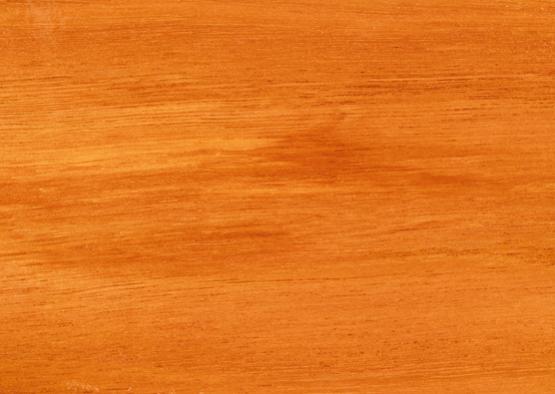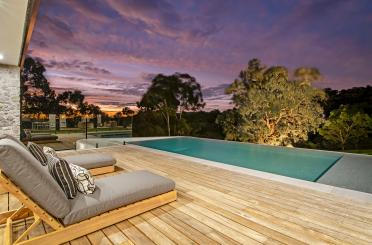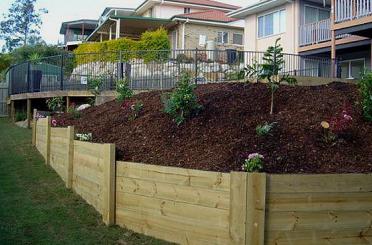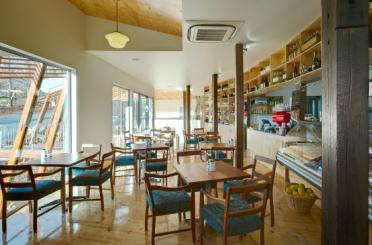Grey gum is an extremely hard and durable native Australian hardwood timber, suitable for a wide range of engineering and construction applications.
Grey Iron Gum, Eucalyptus punctata, Large-fruited Grey Gum, Small-fruited Grey Gum, Eucalyptus canaliculata, Eucalyptus major, Brown Grey Gum,
Eucalyptus propinqua

Grey gum is a medium-sized hardwood tree growing up to 40 metres in height and one metre in stem diameter. Varieties of grey gum occur along the east coast of Australia, from the Hawkesbury River in New South Wales as far north as Maryborough, and inland to the Carnarvon Ranges and Blackdown Tablelands in Queensland.
The heartwood of this species is a red to reddish-brown colour, visually distinct from the paler sapwood. Grain is usually interlocked, with a coarse but even texture. Grey gum is similar in general appearance to the ironbarks, but often marked by characteristic grub holes.
Grey gum timber is extremely durable, with an in-ground life expectancy in excess of 25 years. For aboveground applications, life expectancy exceeds 40 years. Grey gum heartwood is termite-resistant, and untreated sapwood is not susceptible to lyctid borer attack. Grey gum sapwood is readily impregnated with commercially available preservatives.
The timber is very hard, rated 1 on a 6-class scale in relation to both indentation and ease of working with hand tools. It machines well, although care is required in working the timber’s interlocked grain. Grey gum readily accepts paint, stain and polish, and is amenable to the use of standard fastenings and fittings. As with most high-density species, machining and surface preparation should be done immediately prior to the application of adhesives.
Grey gum is widely used in heavy engineering and marine construction, where it is found as poles, piles, railway sleepers, cross-arms and mining timbers. In general construction it is used for building framework, flooring and decking. Grey gum is also extensively used in landscaping and boat building. It is renowned for making superior-quality butcher’s blocks suitable for use in both commercial and domestic environments.
Shrinkage
| Very Low | Low | Medium | High | Very High | |
|---|---|---|---|---|---|

|

|
||||
Tangential : |
7.00%
|
||||
Radial : |
4.50%
|
||||
Unit Movement Tangential: |
|||||
Unit Movement Radial: |
Strength Group

Very High |
High |
Reasonably High |
Medium High |
Medium |
Reasonably Low |
Low |
Very Low |
||
Unseasoned: |
S1 |
S2 |
S3 |
S4 |
S5 |
S6 |
S7 |
S8 |
|
|---|---|---|---|---|---|---|---|---|---|
 |
|||||||||
Seasoned: |
SD1 |
SD2 |
SD3 |
SD4 |
SD5 |
SD6 |
SD7 |
SD8 |
|
 |
Stress Grade

| Structural No. 1 |
Structural No. 2 |
Structural No. 3 |
Structural No. 4 |
Structural No. 5 |
|
Unseasoned: |
F22 |
F22 |
F17 |
F14 |
F11 |
Seasoned: |
F34 |
F27 |
F22 |
F17 |
F14 |
Density per Standard

Seasoned: |
1050kg/m3
|
|---|---|
Unseasoned: |
1250kg/m3
|
Joint Group

Very High |
High |
Reasonably High |
Medium |
Low |
Very Low |
|
Unseasoned: |
J1 |
J2 |
J3 |
J4 |
J5 |
J6 |
|---|---|---|---|---|---|---|
 |
||||||
Seasoned: |
JD1 |
JD2 |
JD3 |
JD4 |
JD5 |
JD6 |
 |
Colour

| White, yellow, pale straw to light brown | Pink to pink brown | Light to dark red | Brown, chocolate, mottled or streaky | |
 |
||||
Mechanical Properties
Modulus of Rupture - Unseasoned: |
110
|
|---|---|
Modulus of Rupture - Seasoned: |
140
|
Modulus of Elasticity - Unseasoned: |
16
|
Modulus of Elasticity - Seasoned: |
18
|
Maximum Crushing Strength - Unseasoned:  |
51
|
Maximum Crushing Strength - Seasoned: |
72
|
Impact - Unseasoned: |
19
|
Impact - Seasoned: |
21
|
Toughness - Unseasoned: |
Medium - 15 - 24 Nm
|
Toughness - Seasoned: |
Medium - 15 - 24 Nm
|
Hardness - Unseasoned: |
10
|
Hardness - Seasoned: |
14
|
Durability
| Low | Moderate | Reasonably High | High | |
| (0 - 5 yrs) | (5 - 15 yrs) | (15 - 25 yrs) | (more than 25 yrs) | |
In-Ground: |
 |
|||
| (0 - 7 yrs) | (7 - 15 yrs) | (15 - 40 yrs) | (More than 40 yrs) | |
Above ground: |
 |
|||
| (0 - 20 yrs, usually < 5) | (21 - 40 yrs) | (41 - 64 yrs) | (More than 60 yrs) | |
Marine Borer Resistance: |
 |
Lyctid Borer Susceptibility: |
Not Susceptible |
|---|---|
Lyctid Borer Susceptibility - Other: |
|
Termite Resistance: |
Resistant
|
Fire Properties
| 1 - non-combustible | 2 - reasonably non-combustible | 3 - slightly combustible | 4 - combustible | |
Fire Properties Group |
Group Number - Other: |
3 if used on MDF or particleboard ≥12mm; veneer thickness 0.6-0.85mm
|
|---|---|
Average Specific Extinction Area: |
<250
|
Bushfire Resistance: |
BAL 12.5 and 19 – All AS3959 required applications
|
The heartwood of this species is a red to red-brown colour, visually distinct from the paler sapwood. Grain is usually interlocked with a coarse but even texture. Grub holes are an occasional feature in sawn timber products.
Grey gum is widely used in heavy engineering and marine construction, where it is found as poles, piles, railway sleepers, cross-arms and mining timbers. In general construction it is used for building framework, flooring and decking.
Grey gum is also extensively used in landscaping and boat building. It is renowned for making quality butcher’s blocks for both commercial and domestic use.
Because of its density and grain structure, grey gum is difficult to work when dry. It machines satisfactorily, although care is required in working the timber’s interlocked grain. Grey gum readily accepts paint, stain and polish, and is amenable to the use of standard fastenings and fittings. As with most high-density species, machining and surface preparation should be done immediately prior to the application of bonding agents.

Decking

Retaining Walls (Landscaping)

Structural Timber Poles

Flooring
Allied Forest Products

Australian Solar Timbers
Australian Timber

Cameron's H Hardware

Coffs Harbour Hardwoods
Dekhar Outdoors

FloorVenue

Garde Timber Pty Ltd

Mathews Timber Pty Ltd

Matilda Veneer

Outlast Timber Supplies

Pentarch Forestry

Ridgewood Timber Pty Ltd

Three(3)DM Pty Ltd

Timber Blitz Pty Ltd
Timber Floors Pty Ltd

Timber Revival

TwentyOne (21) Timbers









